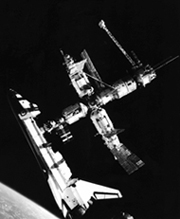
Mir, the first modern-era space station, is launched by the Soviet Union.

Mir (Russian for both “peace” and “world”) came after the U.S. Skylab and Soviet Salyut stations and before the current International Space Station. Mir was assembled in stages; seven of them, counting the original core module. The station became the centerpiece of the Soviet (and later Russian Federation) space program.
The Soviets devoted more time than the Americans did to studying the effects on humans of long-term stays in microgravity. Cosmonauts were typically aloft for much longer periods than astronauts, and Valery Polyakov spent a record 437-plus days aboard Mir (see here).
With the Cold War over, the Russians began welcoming U.S. shuttle crews to Mir as part of the collaborative groundwork for the coming ISS. Seven shuttle missions docked with Mir, their crews remaining aboard for varying lengths of time. As part of this collaboration, NASA agreed to pay for the installation of the Spektr and Priroda modules, the last two pieces of the Mir puzzle. A special docking module to accommodate the U.S. shuttles was also added. So, in a sense, Mir can claim to be the first international space station.
Attempts were made to keep Mir aloft using private money, but all the plans (including one that would have converted it into an orbiting movie studio) came to nothing. Burdened by its financial commitments to the ISS, Russia decided to end Mir’s life. The station’s orbit was gradually decelerated, and on March 23, 2001, Mir came flaming through the atmosphere on its way to a watery grave in the South Pacific. Mir spent 5,511 days in orbit, more than fifteen years.—TL